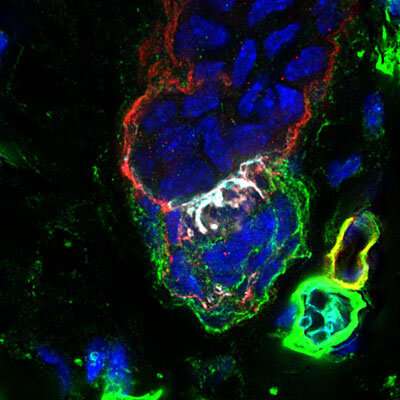Basement membrane underpins tissue interactions in the skin

In a discovery that could pave the way for therapies that promote wound healing and alleviate skin diseases, RIKEN researchers have found that the network of molecules under the outermost layer of mouse skin, the skin epithelium, is a highly specialized zone of biological activity that facilitates distinct sets of interactions between different types of tissues.
The extracellular matrix is a complex scaffold composed of hundreds of regionally specialized proteins that performs multiple roles, including supporting and organizing cells in organs and conveying biochemical signals that control their growth and differentiation.
Sandwiched between the outer epithelium and inner dermis, the basement membrane is a thin sheet of extracellular matrix. "This critical interface in the skin is like an optimally formulated, intelligent glue," explains Hironobu Fujiwara of the RIKEN Center for Biosystems Dynamics Research. But how it operates in interactions between tissues is not well understood.
Now, by using gene-expression analyses and imaging techniques, Fujiwara and his colleagues have systematically characterized the cellular origins, molecular identities and distribution patterns of molecules in the basement membrane of mouse skin. They discovered that, within this tissue interface, there were a diverse series of regionally specialized niches, each impacted by the identity of nearby cells.
Around hair follicles, for instance, the identity of abutting cells in the dermis determined the nature of matrix proteins. Fibroblasts and their associated epithelial cells produced their own sets of proteins to facilitate molecular crosstalk between the two cell types, while epithelial cells facing sensory nerve cells or arrector pili muscles secreted a special concoction of proteins that allowed for unique interactions with those tissues as well.
In particular, the researchers found that the interface between the hair germ, a rudimentary epithelial structure from which a hair develops, and a specialized fibroblast population called the dermal papilla, essential for the development and regeneration of hair follicles, were tangled together in a never-before-described arrangement of basement membrane composition and architecture (Fig. 1).
These 'hook and mesh' basement membranes—so named because of their hooked shape and mesh-like deposition of secreted proteins—could help underpin the exquisite regenerative capacity of hair follicles, the researchers note. A better understanding of these structures could also inform the development of tissue engineering strategies for treating hair loss and other skin conditions.
Beyond the skin, Fujiwara expects to find similar patterns of basement membrane organization in other parts of the body as well. "Although this has not yet been investigated well, if confirmed the spatial patterns we have documented could represent a new paradigm of basement membrane composition and design," he says.
More information: Ko Tsutsui et al, Mapping the molecular and structural specialization of the skin basement membrane for inter-tissue interactions, Nature Communications (2021). DOI: 10.1038/s41467-021-22881-y
Journal information: Nature Communications
Provided by RIKEN





















